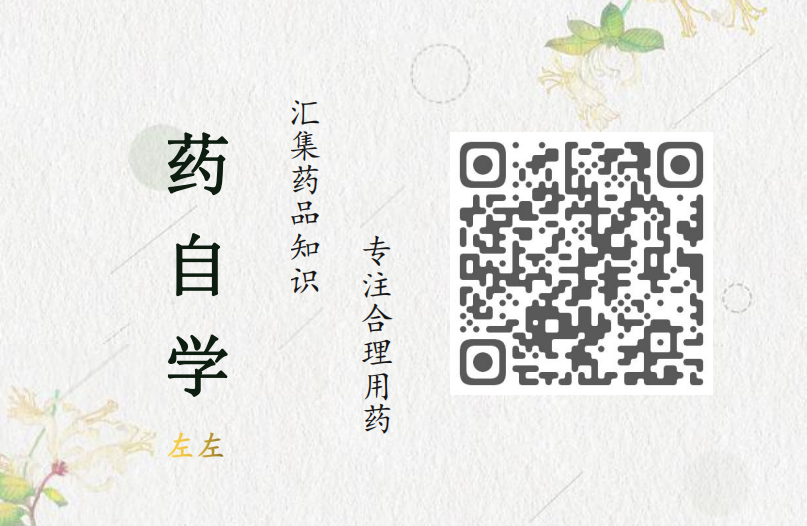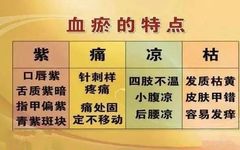 Blood stasis constitution may seem rare, but many people actually have stagnation or blood stasis in their bodies. If you don’t believe it, keep reading.Blood stasis has lost its physiological function, and when it stagnates in the body, it can cause symptoms such as bruising and pain. For example, if it stagnates in the heart, it can lead to chest tightness and heart pain; if it stagnates in the lungs, it can cause chest pain and coughing up blood; if it stagnates in the gastrointestinal tract, it can result in vomiting blood and bloody stools.So how can you determine if you have a blood stasis constitution? Refer to the following symptoms:Grayish complexion, dark circles under the eyes, prone to spots;Dark purple lips, prone to dry throat;Gums easily bleed, hair is dry or falling out;Occasional appearance of purplish skin, bruises, or pain;Prone to irritability, poor memory, forgetfulness;Women may experience dysmenorrhea, with pain worsening at night;Thin body, dry skin, purple or bruised tongue;It is important to note that people with blood stasis constitution often have dry skin, referred to in TCM as “skin and muscle dryness,” which manifests as skin easily peeling, especially in winter, resembling fish scales.People with blood stasis often experience dry throat, which in TCM is described as “wanting to rinse with water but not wanting to swallow,” meaning they only want to moisten their mouth with water but do not want to swallow it. This is due to the presence of blood stasis in the body, where qi cannot transform into fluids, preventing fluids from rising.Some individuals may show prominent red or blue capillaries, such as noticeable red lines on the sides of the nose, cheeks, or inner arms, which are all manifestations of blood stasis.A method to determine the presence of blood stasis is to observe the tongue. A dark purple tongue or bruises on the tongue, along with purple-black veins under the tongue, especially if they are thick, can indicate blood stasis.
Blood stasis constitution may seem rare, but many people actually have stagnation or blood stasis in their bodies. If you don’t believe it, keep reading.Blood stasis has lost its physiological function, and when it stagnates in the body, it can cause symptoms such as bruising and pain. For example, if it stagnates in the heart, it can lead to chest tightness and heart pain; if it stagnates in the lungs, it can cause chest pain and coughing up blood; if it stagnates in the gastrointestinal tract, it can result in vomiting blood and bloody stools.So how can you determine if you have a blood stasis constitution? Refer to the following symptoms:Grayish complexion, dark circles under the eyes, prone to spots;Dark purple lips, prone to dry throat;Gums easily bleed, hair is dry or falling out;Occasional appearance of purplish skin, bruises, or pain;Prone to irritability, poor memory, forgetfulness;Women may experience dysmenorrhea, with pain worsening at night;Thin body, dry skin, purple or bruised tongue;It is important to note that people with blood stasis constitution often have dry skin, referred to in TCM as “skin and muscle dryness,” which manifests as skin easily peeling, especially in winter, resembling fish scales.People with blood stasis often experience dry throat, which in TCM is described as “wanting to rinse with water but not wanting to swallow,” meaning they only want to moisten their mouth with water but do not want to swallow it. This is due to the presence of blood stasis in the body, where qi cannot transform into fluids, preventing fluids from rising.Some individuals may show prominent red or blue capillaries, such as noticeable red lines on the sides of the nose, cheeks, or inner arms, which are all manifestations of blood stasis.A method to determine the presence of blood stasis is to observe the tongue. A dark purple tongue or bruises on the tongue, along with purple-black veins under the tongue, especially if they are thick, can indicate blood stasis.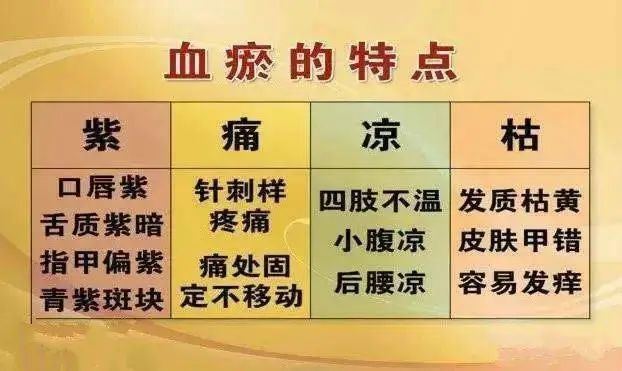 At this point, some people may notice prominent blue veins in different parts of the body, with varying shapes and colors.In TCM, these blue veins represent excessive waste accumulation in the body, indicating blood stasis, phlegm-dampness, heat-toxins, and stagnation. The more waste accumulation, the more pronounced the blue veins.Different shapes and colors indicate different degrees of stagnation: blue veins indicate mild stagnation, protruding veins indicate moderate stagnation, and twisted veins indicate severe stagnation; blue indicates mild, purple indicates moderate, and black indicates severe.Exposed blue veins in different areas indicate different issues, allowing us to roughly assess the condition.Blue veins at the temples: prone to dizziness and headaches; if the veins are protruding or twisted, it may indicate cerebral arteriosclerosis, and if they turn black, it could lead to a stroke.Blue veins on the nose bridge: indicate gastrointestinal stagnation, prone to bloating and abdominal pain, and indigestion; blue veins at the corners of the mouth: suggest gynecological issues, heavy vaginal discharge, and lower back and knee soreness.Blue veins on the back of the hand: indicate stagnation in the lower back, prone to lumbar muscle strain and back pain; blue veins on the fingers: indicate digestive system issues and insufficient blood supply to the head, leading to dizziness and headaches; blue veins on the palm: indicate gastrointestinal stagnation, prone to hypertension and diabetes.Blue veins in the chest and abdomen: suggest liver qi stagnation, pay attention to breast hyperplasia; blue veins in the abdomen: indicate liver cirrhosis.Blue veins at the knees: suggest knee joint swelling and arthritis; blue veins in the calves: often indicate varicose veins, suggesting lumbar and leg diseases, and rheumatic joint pain.In addition to the above manifestations, individuals with blood stasis constitution are also prone to weight loss and menstrual irregularities. Women may also exhibit irritability and liver qi stagnation, which can be addressed with Chai Hu Shu Gan San (Bupleurum Powder to Spread the Liver) or Xiao Yao Wan (Free and Easy Wanderer Pill).Moreover, individuals with blood stasis are prone to pain, which has a characteristic of being fixed and not moving, rather than migrating pain; also, the pain is lighter during the day and worsens at night.
At this point, some people may notice prominent blue veins in different parts of the body, with varying shapes and colors.In TCM, these blue veins represent excessive waste accumulation in the body, indicating blood stasis, phlegm-dampness, heat-toxins, and stagnation. The more waste accumulation, the more pronounced the blue veins.Different shapes and colors indicate different degrees of stagnation: blue veins indicate mild stagnation, protruding veins indicate moderate stagnation, and twisted veins indicate severe stagnation; blue indicates mild, purple indicates moderate, and black indicates severe.Exposed blue veins in different areas indicate different issues, allowing us to roughly assess the condition.Blue veins at the temples: prone to dizziness and headaches; if the veins are protruding or twisted, it may indicate cerebral arteriosclerosis, and if they turn black, it could lead to a stroke.Blue veins on the nose bridge: indicate gastrointestinal stagnation, prone to bloating and abdominal pain, and indigestion; blue veins at the corners of the mouth: suggest gynecological issues, heavy vaginal discharge, and lower back and knee soreness.Blue veins on the back of the hand: indicate stagnation in the lower back, prone to lumbar muscle strain and back pain; blue veins on the fingers: indicate digestive system issues and insufficient blood supply to the head, leading to dizziness and headaches; blue veins on the palm: indicate gastrointestinal stagnation, prone to hypertension and diabetes.Blue veins in the chest and abdomen: suggest liver qi stagnation, pay attention to breast hyperplasia; blue veins in the abdomen: indicate liver cirrhosis.Blue veins at the knees: suggest knee joint swelling and arthritis; blue veins in the calves: often indicate varicose veins, suggesting lumbar and leg diseases, and rheumatic joint pain.In addition to the above manifestations, individuals with blood stasis constitution are also prone to weight loss and menstrual irregularities. Women may also exhibit irritability and liver qi stagnation, which can be addressed with Chai Hu Shu Gan San (Bupleurum Powder to Spread the Liver) or Xiao Yao Wan (Free and Easy Wanderer Pill).Moreover, individuals with blood stasis are prone to pain, which has a characteristic of being fixed and not moving, rather than migrating pain; also, the pain is lighter during the day and worsens at night.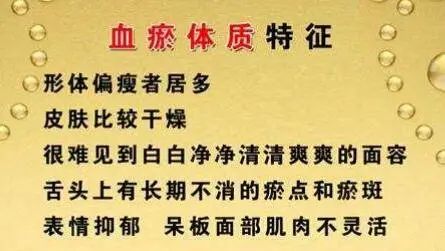 Where does blood stasis come from?Blood stasis can arise from different situations, such as qi stagnation leading to blood stasis, qi deficiency leading to blood stasis, cold congealing blood stasis, as well as trauma and other causes of internal bleeding.Qi stagnation leading to blood stasis occurs because qi can promote blood circulation. If liver qi is not smooth, often feeling pent-up, qi stagnation prevents blood from circulating, leading to blood stasis.Qi deficiency leading to blood stasis follows the same principle; qi is the commander of blood, and if qi is deficient, it cannot promote blood circulation, causing blood to stagnate in one place.Cold congealing blood stasis occurs when cold pathogens cause blood circulation to be obstructed, such as being exposed to cold winds or wearing skirts in winter, which is why many people experience cold hands and feet more in winter.Trauma and injury are common occurrences in daily life, and sometimes one may feel fine at the moment but develop bruising and swelling the next day, indicating blood stasis.This is particularly important for children, as they may not realize they have bumped into something, and parents often overlook it, leading to blood stasis.Additionally, some surgical procedures can lead to blood stasis, such as women experiencing blood stasis after cesarean sections or miscarriages, where blood is not expelled completely and remains in the body, leading to gynecological issues. A postpartum formula for expelling blood stasis is called Sheng Hua Tang (Generation and Transformation Decoction).
Where does blood stasis come from?Blood stasis can arise from different situations, such as qi stagnation leading to blood stasis, qi deficiency leading to blood stasis, cold congealing blood stasis, as well as trauma and other causes of internal bleeding.Qi stagnation leading to blood stasis occurs because qi can promote blood circulation. If liver qi is not smooth, often feeling pent-up, qi stagnation prevents blood from circulating, leading to blood stasis.Qi deficiency leading to blood stasis follows the same principle; qi is the commander of blood, and if qi is deficient, it cannot promote blood circulation, causing blood to stagnate in one place.Cold congealing blood stasis occurs when cold pathogens cause blood circulation to be obstructed, such as being exposed to cold winds or wearing skirts in winter, which is why many people experience cold hands and feet more in winter.Trauma and injury are common occurrences in daily life, and sometimes one may feel fine at the moment but develop bruising and swelling the next day, indicating blood stasis.This is particularly important for children, as they may not realize they have bumped into something, and parents often overlook it, leading to blood stasis.Additionally, some surgical procedures can lead to blood stasis, such as women experiencing blood stasis after cesarean sections or miscarriages, where blood is not expelled completely and remains in the body, leading to gynecological issues. A postpartum formula for expelling blood stasis is called Sheng Hua Tang (Generation and Transformation Decoction).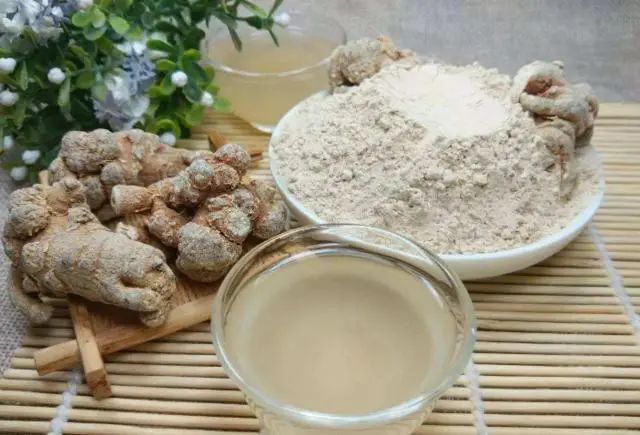 So how can individuals with blood stasis constitution regulate themselves?Rose TeaIn daily life, rose flowers are seen as symbols of love and romance, but in traditional Chinese medicine, rose has the effects of soothing the liver, relieving depression, and promoting blood circulation to alleviate pain.For those with liver qi stagnation and seeking to beautify and reduce spots, an appropriate amount of rose can be used to brew tea; for those with cold congealing qi stagnation and spleen-stomach deficiency, rose, rock sugar, and white wine can be soaked for a month before consumption.Tao Hong Si Wu Tang (Peach Blossom Four Substance Decoction)Tao Hong Si Wu Tang consists of Si Wu Tang (Four Substance Decoction) plus Tao Ren (Peach Kernel) and Hong Hua (Safflower), with a reference dosage of 10 to 15 grams for each herb.In Si Wu Tang, Dang Gui (Angelica Sinensis) nourishes and invigorates the blood, Bai Shao (White Peony) nourishes the blood and softens the liver, Chuan Xiong (Szechuan Lovage) invigorates blood and promotes qi, and Shu Di Huang (Rehmannia) nourishes yin and replenishes blood. Shu Di and Bai Shao are yin and soft, while Dang Gui and Chuan Xiong are spicy and fragrant, combining movement and stillness.Additionally, Hong Hua invigorates blood and regulates menstruation, dispelling invisible blood stasis; Tao Ren invigorates blood and dispels visible blood stasis.San Qi and Xi Yang Shen PowderSan Qi (Notoginseng) powder and Xi Yang Shen (American Ginseng) powder can be taken at 1 gram each, and in severe cases, up to 3 grams can be used. Generally, a daily dosage of 1 gram each is sufficient for regulation.San Qi is commonly regarded as a blood-invigorating herb, but it also has hemostatic properties, famously known for “stopping bleeding without leaving stasis and transforming stasis without harming the normal.” It can regulate both blood stasis and bleeding.Why combine San Qi with Xi Yang Shen? Firstly, because San Qi is warming, some people may experience heat after taking it, while Xi Yang Shen is cooling and can nourish qi and yin; secondly, Xi Yang Shen tonifies qi, promoting blood circulation.Other RegulationsFoods such as hawthorn, leeks, garlic, cinnamon, black fungus, and lotus root can be consumed more; TCM herbs such as San Qi, Yi Mu Cao (Motherwort), rose, Dan Shen (Salvia), Dang Gui, and saffron can be referenced.For those interested in acupuncture and massage, points such as Shen Que (Conception Vessel 8), Tai Chong (Liver 3), and Qu Chi (Large Intestine 11) can be referenced. For gynecological issues, Tai Chong and San Yin Jiao (Spleen 6) can be referenced, and gua sha (scraping therapy) can also be used.Note that the above regulation methods and herbs should not be attempted by pregnant women; individuals with bleeding disorders should also avoid them and seek medical advice.During the regulation process for blood stasis constitution, in addition to observing symptoms and signs, it is also important to observe the tongue. Individuals with blood stasis have a dark purple tongue, and purple-black veins under the tongue. If the tongue color lightens, it indicates effectiveness.
So how can individuals with blood stasis constitution regulate themselves?Rose TeaIn daily life, rose flowers are seen as symbols of love and romance, but in traditional Chinese medicine, rose has the effects of soothing the liver, relieving depression, and promoting blood circulation to alleviate pain.For those with liver qi stagnation and seeking to beautify and reduce spots, an appropriate amount of rose can be used to brew tea; for those with cold congealing qi stagnation and spleen-stomach deficiency, rose, rock sugar, and white wine can be soaked for a month before consumption.Tao Hong Si Wu Tang (Peach Blossom Four Substance Decoction)Tao Hong Si Wu Tang consists of Si Wu Tang (Four Substance Decoction) plus Tao Ren (Peach Kernel) and Hong Hua (Safflower), with a reference dosage of 10 to 15 grams for each herb.In Si Wu Tang, Dang Gui (Angelica Sinensis) nourishes and invigorates the blood, Bai Shao (White Peony) nourishes the blood and softens the liver, Chuan Xiong (Szechuan Lovage) invigorates blood and promotes qi, and Shu Di Huang (Rehmannia) nourishes yin and replenishes blood. Shu Di and Bai Shao are yin and soft, while Dang Gui and Chuan Xiong are spicy and fragrant, combining movement and stillness.Additionally, Hong Hua invigorates blood and regulates menstruation, dispelling invisible blood stasis; Tao Ren invigorates blood and dispels visible blood stasis.San Qi and Xi Yang Shen PowderSan Qi (Notoginseng) powder and Xi Yang Shen (American Ginseng) powder can be taken at 1 gram each, and in severe cases, up to 3 grams can be used. Generally, a daily dosage of 1 gram each is sufficient for regulation.San Qi is commonly regarded as a blood-invigorating herb, but it also has hemostatic properties, famously known for “stopping bleeding without leaving stasis and transforming stasis without harming the normal.” It can regulate both blood stasis and bleeding.Why combine San Qi with Xi Yang Shen? Firstly, because San Qi is warming, some people may experience heat after taking it, while Xi Yang Shen is cooling and can nourish qi and yin; secondly, Xi Yang Shen tonifies qi, promoting blood circulation.Other RegulationsFoods such as hawthorn, leeks, garlic, cinnamon, black fungus, and lotus root can be consumed more; TCM herbs such as San Qi, Yi Mu Cao (Motherwort), rose, Dan Shen (Salvia), Dang Gui, and saffron can be referenced.For those interested in acupuncture and massage, points such as Shen Que (Conception Vessel 8), Tai Chong (Liver 3), and Qu Chi (Large Intestine 11) can be referenced. For gynecological issues, Tai Chong and San Yin Jiao (Spleen 6) can be referenced, and gua sha (scraping therapy) can also be used.Note that the above regulation methods and herbs should not be attempted by pregnant women; individuals with bleeding disorders should also avoid them and seek medical advice.During the regulation process for blood stasis constitution, in addition to observing symptoms and signs, it is also important to observe the tongue. Individuals with blood stasis have a dark purple tongue, and purple-black veins under the tongue. If the tongue color lightens, it indicates effectiveness.

How to Regulate Damp-Heat Constitution?
How to Regulate Phlegm-Damp Constitution?
For the Chinese and Western medicines and formulas mentioned in this article, please use them under the guidance of professionals.
TCM enthusiasts can join the “Reader Group” on the public account homepage for interaction and communication.
